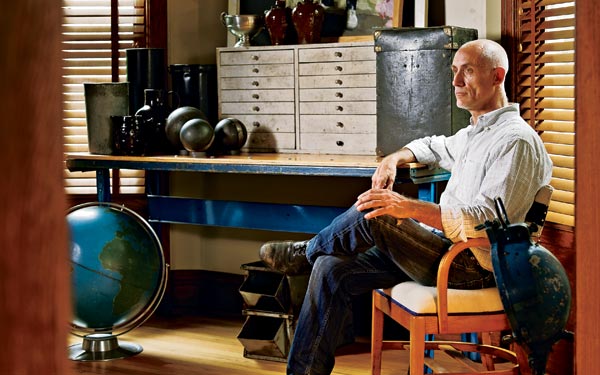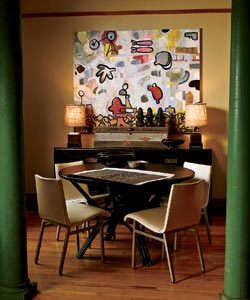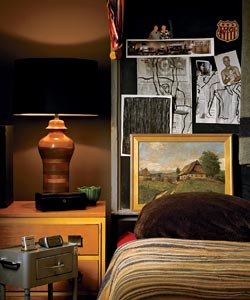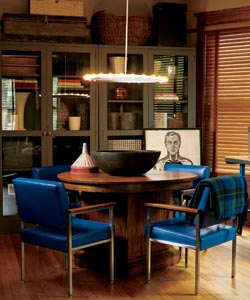
Vodak sits on a chair re-covered with a vintage wool U.S. Navy blanket by Julie Fernstrom of English Cottage; the 1958 painting The Boxer, by Nikolai Geveliuk, is on loan from friends Thea and Frank Polancic. |
The owner: Larry Vodak, the shopkeeper (as he likes to put it) at Scout, an antique shop at 5221 N. Clark St. The digs: A two-bedroom apartment on the second floor of a vintage brick two-flat, a few blocks away from Scout. He lives here with his son, Will, who is currently at college in Ohio.The aesthetic: Like his shop, it feels like a cozy and unpretentious urban cottage, with plenty of nicked-up wood furniture and flea-market treasures, and some industrial pieces mixed in. "There’s something about cottage elements that suspend the need to be perfect," he says. "Although this is my first home, I treat it like my second home. I don’t obsess over how it looks; I care how I feel in it and I care how others feel in it." Big ideas: If you’ve spent any time in Scout, you know that Vodak loves large pieces—and he’s not afraid to fill his small apartment with them. Two glass-doored metal cabinets filled with oversize vases and other vessels (and, as if this were not enough, topped with a large basket and a pile of suitcases) take up one wall in his dining room. He bought the cabinets, once a dirty mustard color (he had them painted gray, a staple—along with black—in the Vodak color palette), at Brownstone Antiques, right across the street from his shop. "For months and months they were there, and no one noticed them because they were filled with junk," says Vodak, who stops by Brownstone daily. "Then one day I looked at them and said, "These are incredible! Let’s take them out! Let’s paint them!’" Also in the dining room, Vodak breaks up the calming sea of gray, black, and wood with old cobalt blue chairs from a General Motors assembly plant waiting room and an industrial table with a base painted the same color (the latter made by his friend Michelle Peterson-Albandoz, the owner of Las Manos Gallery, also across the street—Vodak is big on supporting his neighbors).
 |
 |
|
Vodak picked up the green columns (above) at Jayson Home & Garden’s European Flea Market this past spring; the painting above the credenza from White Attic is by artist Chuck Rolwing (from Las Manos Gallery). A blackboard/headboard stands behind the bed. |
|
The essentials: Interesting combinations of wood, leather, upholstery, and metal in pieces with simple, clean lines. Other standbys: Blackboards (Vodak uses one as a headboard in his bedroom, and has pictures of family and friends pasted on; "It’s my life board," he jokes) and framed black-and-white artwork, ranging from old scientific charts and drawings of fish ("I love fish!") to fine art photography by local artists Michael McGuire and Scott Gruss. He has a penchant for subtlety. "You don’t even see them," he says proudly, pointing to two large framed vintage botanical posters in his dining room. "It’s not like, "Oh God, look at that art!’" He’s also crazy about local artisan Ted Harris’s lamps, made from found objects and more often than not topped off with shades from A Lamp & Fixture Shop on Elston Avenue. On the floor: Sisal rugs and a factory conveyer belt purchased from interior decorator Laura Soskin and repurposed as a runner. "I’m not too good with rugs," says Vodak. "I don’t like patterns. I’m more of a monochromatic guy."
 |
 |
|
Glass-doored cabinets loom large in the living room (left) and dining room. |
|
Vodak’s Law #1: The backs of your chairs should be about the same height as your table. This rule proves itself in the alcove off the living room that Vodak uses as his study. There, four white pleather chairs from Daniel’s Antiques poke out just a smidge from under an old rattan table that Vodak painted black, and it makes you wonder why no one ever mentioned this tip before. And Law #2: Just say no to couches. Two loveseats facing each other is Vodak’s tried-and-true formula; he has reupholstered the same two Crate & Barrel loveseats (he thinks they’re from the store’s first collection) six times over the past 18 years. Currently, they’re covered in a sage herringbone from Calico Corners, a fabric he frequently uses on pieces in his store ("there’s not a color combination it doesn’t work with"). As for the throw pillows: "These are probably something I spent more time laboring over than anything else," he says. Made out of vintage English plaid blankets by Julie Fernstrom (who has hundreds to choose from at her Portage Park antique shop, English Cottage), they are signature Scout: invitingly countryish, yet somehow still modern.
Photography: Matthew Gilson
Related: Five Uses For… and This Old House


